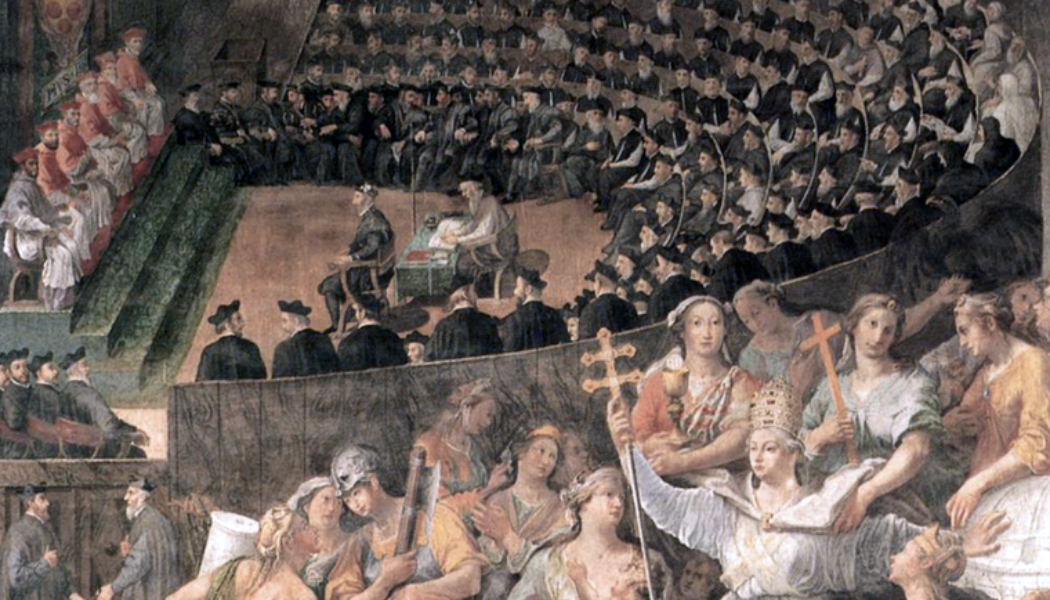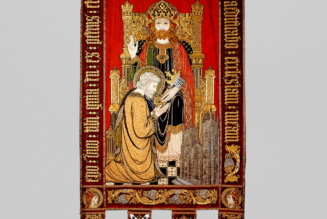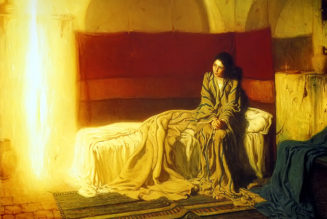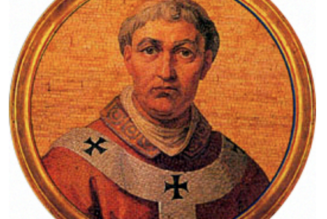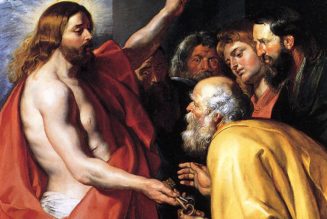
In a recent interview, Pope Francis invoked St. Vincent of Lérins in relation to the concept of doctrinal development — especially as a remedy to what the Pope called indietrismo (an attitude of “being backward-looking”) among some Catholics. He has done so previously.
The linkage of doctrinal development to Vincent of Lérins may come as a surprise for two reasons. One is that the concept is commonly linked to St. John Henry Newman, and the other is that Vincent is most famous for a quotation that some might take as rejecting doctrinal development.
Here are five things to know and share.
1) Who was St. Vincent of Lérins?
Vincent of Lérins was a French monk who lived in the early 400s. He belonged to a monastery on the Island of St. Honorat, one of the Lérins Islands off the southern coast of France.
When Vincent was born is unknown. His death occurred sometime between A.D. 434 and 450.
One of the controversies of his time centered on questions of grace, free will, predestination and original sin. The two poles of this debate were the British monk Pelagius and the North African bishop St. Augustine. The former stressed free will and minimized the role of grace in the Christian life, while the latter did the reverse.
Many in this time were not fully satisfied with the positions proposed by either Pelagius or Augustine, and some advocated middle positions, some of which were later deemed heretical and referred to as “semi-Pelagianism.”
Like many in France at this time, Vincent has been regarded as a semi-Pelagian, but it is unclear what his exact position was. Further, since semi-Pelagianism had not been condemned in his day, he was not blocked from being regarded as a saint.
His feast day in the Roman Martyrology is May 24.
2) What is St. Vincent famous for writing?
We may have more than one work that Vincent penned, but the only one regarded as certainly by him is called the Commonitories (from a Latin term meaning “remembrances” or “warnings”).
He wrote it under the pen name Peregrinus (Latin, “the Pilgrim”), and he composed it about the year 434 — three years after the Council of Ephesus declared that the Blessed Virgin Mary can be referred to as the Theotokos (Greek, “God-Bearer” or “Mother of God”).
This title is not found in Scripture and arose from popular piety. As a result, some viewed it as an impermissible addition to Christian faith and practice.
Between the Theotokos controversy and the Pelagian-Augustinian controversy, the topic of whether developments of doctrine were legitimate or heretical was under discussion at the time.
It was in this context that Vincent wrote the Commonitories, and he set before himself the task of determining how to distinguish the true Catholic faith from heresies, writing:
With great zeal and full attention I often inquired from many men, outstanding in sanctity and doctrinal knowledge, how, in a concise and, so to speak, general and ordinary way, I might be able to discern the truth of the Catholic faith from the falsity of heretical corruption.
From almost all of them I always received the answer that if I or someone else wanted to expose the frauds of the heretics and escape their snares and remain sound in the integrity of faith, I had, with the help of the Lord, to fortify that faith in a twofold manner: first, by the authority of the divine Law; second, by the tradition of the Catholic Church.
Vincent thus appeals to both Scripture and Tradition, and the Commonitories has passages that have been cited both by those who are cautious about the idea of doctrinal development and by those who are enthusiastic about it.
3) What did Vincent write that those who are cautious about doctrinal development cite?
Vincent explains that, although Scripture is “more than sufficient in itself,” it is interpreted in different and heretical ways by some people, and so he explains that one must interpret it in light of how it has been read in the Church. He states:
In the Catholic Church itself, every care should be taken to hold fast to what has been believed everywhere, always and by all [quod ubique, quod semper, quod ab omnibus].
This is truly and properly ‘Catholic,’ as indicated by the force and etymology of the name itself, which comprises everything truly universal.
This general rule will be truly applied if we follow the principles of universality, antiquity and consent.
This is the most famous passage in St. Vincent. It is an expression of what has become known as the “Vincentian Canon” and — taken on its own — it could be read as putting a firm break on any doctrinal development.
If we must “hold fast to what has been believed everywhere, always and by all,” then that could seem to leave no room for development in Catholic teaching over time.
The passage thus has been cited by those who wish to deemphasize the possibility of doctrinal development.
However, this is not the only thing that Vincent has to say on the subject.
4) What did Vincent write that those who are enthusiastic about doctrinal development cite?
Later in the Commonitories, Vincent makes it clear that he believes in the idea of doctrinal development, which he refers to as “progress [profectus] of religion.” He writes:
Teach precisely what you have learned; do not say new things even if you say them in a new manner.
At this point, the question may be asked: If this is right, then is no progress of religion possible within the Church of Christ?
To be sure, there has to be progress, even exceedingly great progress.
You’ll notice that one of the things Vincent mentions is the possibility of teaching things one has learned in the past but saying them “in a new manner.”
This refers to the controversies the Church had gone through in which new vocabulary was introduced to express ideas handed down from the apostles — such as saying that Christ is homoousios (Greek, “consubstantial”) with the Father or that Mary is Theotokos.
This teaching of ancient things “in a new manner” thus refers to a form of what is today called doctrinal development. He later refers to this as “presenting in new words the old interpretation of the faith.”
To explain his idea of progress or development, Vincent states that:
It must be progress in the proper sense of the word, and not a change in faith.
Progress means that each thing grows within itself, whereas change implies that one thing is transformed into another.
Hence, it must be that understanding, knowledge and wisdom grow and advance mightily and strongly in individuals as well as in the community, in a single person as well as in the Church as a whole, and this gradually according to age and history.
Vincent then offers an analogy:
The growth of religion in the soul should be like the growth of the body, which in the course of years develops and unfolds, yet remains the same as it was.
Much happens between the prime of childhood and the maturity of old age.
But the old men of today who were the adolescents of yesterday, although the figure and appearance of one and the same person have changed, are identical.
There remains one and the same nature and one and the same person.
The limbs of infants are small, those of young men large — yet they are the same.
By contrast, he states:
If, on the other hand, the human form were turned into a shape of another kind, or if the number of members of the body were increased or decreased, then the whole body would necessarily perish, or become a monstrosity, or be in some way disabled.
In the same way, the dogma of the Christian religion ought to follow these laws of progress, so that it may be consolidated in the course of years, developed in the sequence of time, and sublimated by age [ut annis scilicet consolidetur, dilatetur tempore, sublimetur aetate] — yet remain incorrupt and unimpaired, complete and perfect in all the proportions of its parts and in all its essentials.
Finally, he states:
It is right that those ancient dogmas of heavenly philosophy should in the course of time be thoroughly cared for, filed and polished; but it is sinful to change them, sinful to behead them or mutilate them.
They may take on more evidence, clarity and distinctness, but it is absolutely necessary that they retain their plenitude, integrity and basic character.
Vincent thus believes in a form of doctrinal development whereby what has been passed down from ancient times can be expressed in new words that provide greater clarity and distinctness but that leave its fundamental substance unaltered.
5) What should we make of St. Vincent’s discussion of these points?
It is clear that Vincent is aware the Catholic faith can be expressed (and has come to be expressed) in ways that were not used in the past, and thus that a form of doctrinal development occurs.
However, this is not a form of development without limits. For Vincent, something is only a genuine development if it preserves what was authoritatively handed down from the beginning — at least implicitly, similar to the way men may grow beards even though babies don’t have them.
Vincent thus seeks to strike a balance that acknowledges the necessity of doctrinal continuity with the past and the need for variability of expression with time in order to bring out ancient truths more clearly in the present.
This is essentially the form of doctrinal development endorsed by St. John Henry Newman and — more recently — by Benedict XVI.
In the Commonitories, Vincent has more to say about the application of the principles he describes — and applying the principles correctly is the real challenge.
However, it would be a mistake to focus on the Vincentian Canon to the exclusion of doctrinal development — as if all development is illegitimate — or to focus on his statements about doctrinal development to the exclusion of the Vincentian Canon — as if we could engage in a form of development untethered from the teaching of Christ and the apostles.
Vincent believed in both continuity and development.
